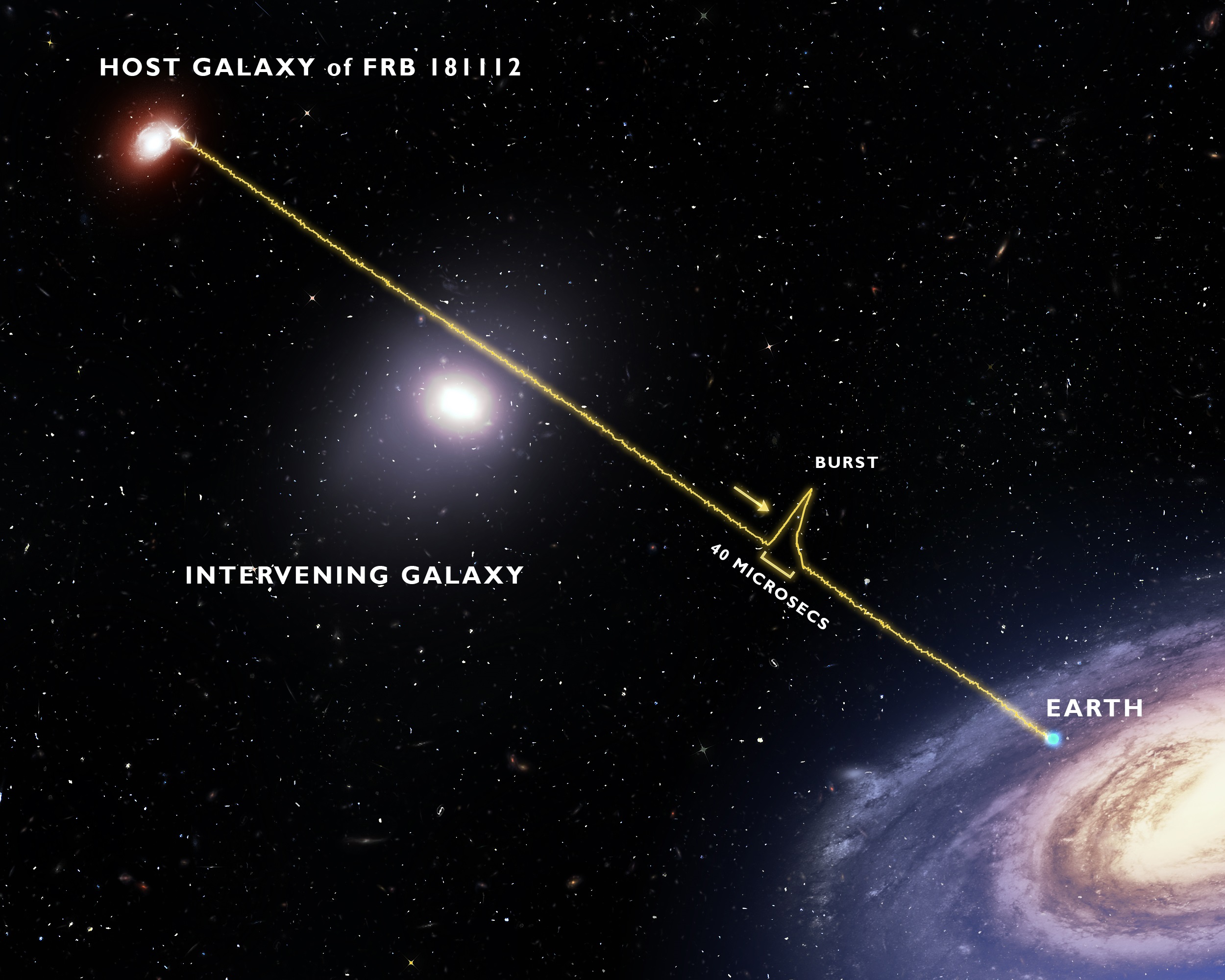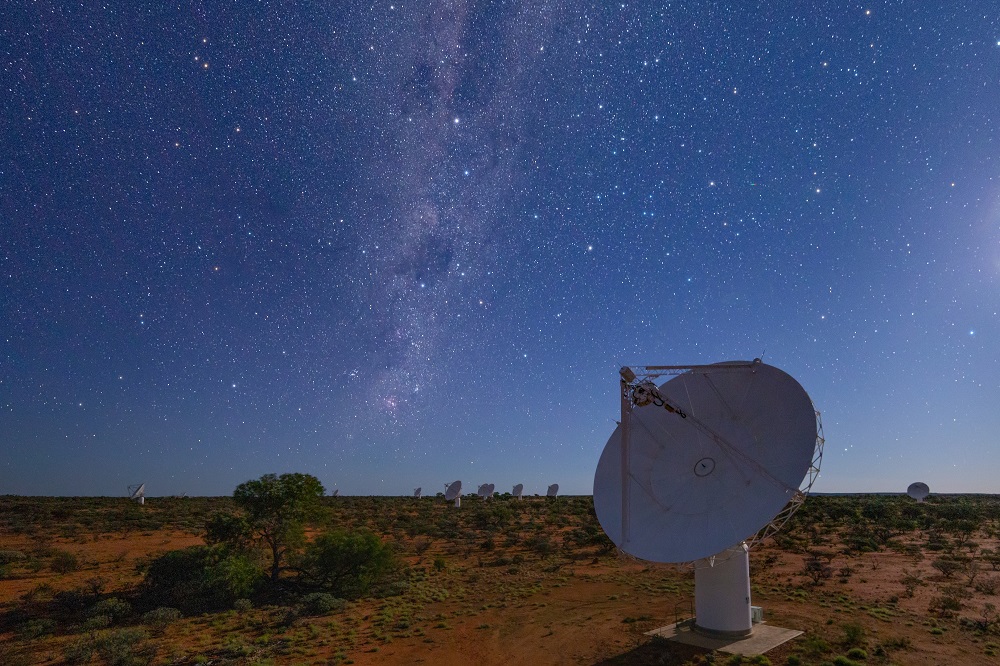ASKAP detects FRB and reveals new information about galactic halos
CSIRO’s Australian Square Kilometre Array Pathfinder (ASKAP) radio telescope has detected and localised another fast radio burst and found that it toured through the halo of an intervening galaxy on its journey to Earth. Astronomers have analysed the burst’s signal to reveal new information about galactic halos.
We know that a halo of low-density gas extends far beyond the luminous part of a galaxy where the stars are concentrated and the gas makes up more of a galaxy’s mass than stars do however it is nearly impossible to see.
“The signal from the fast radio burst exposed the nature of the magnetic field around the galaxy and the structure of the halo gas. The study proves a new and transformative technique for exploring the nature of galaxy halos,” said Xavier Prochaska, Professor of Astronomy and Astrophysics at UC Santa Cruz and lead author of a paper on the new findings published in Science.
Co-author and ASKAP CRAFT team member, Associate Professor Jean-Pierre Macquart, from the Curtin University node of the International Centre for Radio Astronomy Research (ICRAR), said gas on the outskirts of galaxies has traditionally been hard to study.
FRB181112, detected by ASKAP in November 2018, shot through the intervening galaxy’s halo, like a lighthouse beam cutting through fog.

Analysing the fast radio burst's journey through the Universe
Macquart said the research team looked at how the fast radio burst distorted as it travelled five billion light-years through the Universe.
The researchers expected the signal from the burst to be distorted by the galaxy.
“If you go out on a hot summer’s day, you see the air shimmering and the trees in the background look distorted because of the temperature and density fluctuations in the air,” he said.
“That’s what we thought would happen, that the signal from the fast radio burst would be completely distorted after passing through the hot atmosphere of the galaxy.
“But instead of the stormy galactic ‘weather’ we were expecting, the pulse we observed had travelled through a calm sea of unperturbed gas.”
A fossil record for galaxies
The finding suggests that galaxy halos are much more serene than previously thought, with gas that is less turbulent, less dense and less magnetised than expected.
One reason astronomers are so interested in galaxy halos is because they can help us understand why material is ejected from galaxies, causing them to stop growing.
Prochaska, who led the research, said halo gas provides a fossil record of these ejection processes.
“Our observations can inform theories about how matter is ejected and how magnetic fields are transported from the galaxy,” he said.
CSIRO’s Dr Keith Bannister said that as with all fast radio bursts, we could see the total amount of ionised gas it went through (from the frequency-dependant speed of radio waves as they pass through the gas), the lumpiness of that gas (which causes shimmering, similar to the road on a hot day) and the magnetic field in that gas (using polarisation).
"What we find is that the total gas content was low, the gas was very smooth, and there was very little magnetic field - all this at odds with predictions of what nearby galaxy halos should look like," he said.
Analysing the polarisation as a function of frequency gives a “rotation measure” for the halo, which the researchers found to be very low.
“The weak magnetic field in the halo is a billion times weaker than that of a refrigerator magnet,” Prochaska said.
At this point, with results from only one galactic halo, the researchers cannot say whether the unexpectedly low density and magnetic field strength are unusual or if previous studies of galactic halos have overestimated these properties.
ASKAP and other radio telescopes will use fast radio bursts to study many more galactic halos and resolve their properties.
“This galaxy may be special,” Prochaska said. “We will need to use FRBs to study tens or hundreds of galaxies over a range of masses and ages to assess the full population.”
How did ASKAP do it?
“ASKAP is a fantastic FRB finding-machine, thanks to its novel phased array feed technology that gives it a huge field-of-view, 100 times larger than the full Moon,” said Bannister.
ASKAP also has a special FRB finding mode that enables it to know that an FRB has happened within about 0.5 seconds.
Localisation is another key ASKAP capability.
When a fast radio burst is detected, 3 seconds of raw data is downloaded from the telescopes for later processing. When astronomers process that data, they can work out exactly where in the sky the FRB came from, typically with a precision of the size of a human hair at 200 metres.
So not only did ASKAP find it, but it localised its position to a galaxy at z=0.48.
The research team noticed immediately from optical imaging obtained with the European Southern Observatory (ESO) Very Large Telescope (VLT) that the burst passed very close to a foreground galaxy - at z=0.37.
This FRB had flown less than 30kpc from the centre of the foreground galaxy, it travelled through the halo of a massive, foreground galaxy on its way towards Earth.
"For the first time, we could observe what a relatively nearby galaxy halo does to an FRB signal; and the answer is - not much”, said Dr Bannister.

Collaborating with the European Southern Observatory's (ESO) Very Large Telescope (VLT)
“When we overlaid the radio and optical images, we could see straight away that the fast radio burst pierced the halo of this coincident foreground galaxy and, for the first time, we had a direct way of investigating this otherwise invisible matter surrounding this galaxy,”
said coauthor Cherie Day at Swinburne University of Technology, Australia.
CSIRO acknowledges the Wajarri Yamaji as the traditional owners of the Murchison Radio-astronomy Observatory site.
